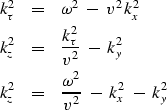![[*]](http://sepwww.stanford.edu/latex2html/cross_ref_motif.gif) ) into (
) into (![[*]](http://sepwww.stanford.edu/latex2html/cross_ref_motif.gif) )
gives (
)
gives (![[*]](http://sepwww.stanford.edu/latex2html/cross_ref_motif.gif) ) where
) where
In an operations environment, 3-D is much harder to cope with than 2-D. Therefore, it may be expedient to suppose that 3-D migration can be achieved merely by application of 2-D migration twice, once in the x-direction and once in the y-direction. The previous section would lead you to believe that such an expedient process would result in a significant degradation of accuracy. In fact, the situation is much better than might be supposed. It has been shown by Jakubowicz and Levin [1983] that, wonder of wonders, for a constant-velocity medium, the expedient process is exact.
The explanation is this: migration consists of more than downward continuation. It also involves imaging, that is, the selection of data at t=0. In principle, downward continuation is first completed, for both the x and the y directions. After that, the imaging condition is applied. In the expedient process there are four steps: downward continuation in x, imaging, downward continuation in y, and finally a second imaging. Why it is that the expedient procedure gives the correct result seems something of a puzzle, but the validity of the result is easy to demonstrate.
First note that substitution of (![[*]](http://sepwww.stanford.edu/latex2html/cross_ref_motif.gif) ) into (
) into (![[*]](http://sepwww.stanford.edu/latex2html/cross_ref_motif.gif) )
gives (
)
gives (![[*]](http://sepwww.stanford.edu/latex2html/cross_ref_motif.gif) ) where
) where
 |
(77) | |
| (78) | ||
| (79) |
![[*]](http://sepwww.stanford.edu/latex2html/cross_ref_motif.gif) ) represents travel time
to an arbitrary point scatterer.
For a 2-D survey recorded along the y-axis,
i.e.,
at constant x, equation (
) represents travel time
to an arbitrary point scatterer.
For a 2-D survey recorded along the y-axis,
i.e.,
at constant x, equation (![[*]](http://sepwww.stanford.edu/latex2html/cross_ref_motif.gif) ) is the traveltime curve.
In-line hyperbolas cannot be distinguished from sideswipe hyperbolas.
2-D migration with equation (
) is the traveltime curve.
In-line hyperbolas cannot be distinguished from sideswipe hyperbolas.
2-D migration with equation (![[*]](http://sepwww.stanford.edu/latex2html/cross_ref_motif.gif) ) brings the energy up to t1.
Subsequently migrating the other direction with equation (
) brings the energy up to t1.
Subsequently migrating the other direction with equation (![[*]](http://sepwww.stanford.edu/latex2html/cross_ref_motif.gif) )
brings the energy up the rest of the way to t0.
This is the same result as the one
given by the more costly 3-D procedure migrating with (
)
brings the energy up the rest of the way to t0.
This is the same result as the one
given by the more costly 3-D procedure migrating with (![[*]](http://sepwww.stanford.edu/latex2html/cross_ref_motif.gif) ).
).
The Jakubowicz justification is somewhat more mathematical,
but may be paraphrased as follows.
First note that substitution of (![[*]](http://sepwww.stanford.edu/latex2html/cross_ref_motif.gif) ) into (
) into (![[*]](http://sepwww.stanford.edu/latex2html/cross_ref_motif.gif) )
gives (
)
gives (![[*]](http://sepwww.stanford.edu/latex2html/cross_ref_motif.gif) ) where
) where
 |
(80) | |
| (81) | ||
| (82) |
![[*]](http://sepwww.stanford.edu/latex2html/cross_ref_motif.gif) ).
The second two-dimensional migration over y may be regarded
as a transformation from pseudodepth
).
The second two-dimensional migration over y may be regarded
as a transformation from pseudodepth ![[*]](http://sepwww.stanford.edu/latex2html/cross_ref_motif.gif) ).
The composite is the same as equation (
).
The composite is the same as equation (![[*]](http://sepwww.stanford.edu/latex2html/cross_ref_motif.gif) ),
which depicts 3-D migration.
),
which depicts 3-D migration.
The validity of the Jakubowicz result goes somewhat beyond its proof. Our two-dimensional geophysicist may be migrating other offsets besides zero offset. If a good job is done, all the reflected energy moves up to the apex of the zero-offset hyperbola. Then the cross-plane migration can handle it if it can handle zero offset. So offset is not a problem. But can a good job be done of bringing all the energy up to the apex of the zero-offset hyperbola?
Difficulty arises when the velocity of the earth is depth-dependent, as it usually is. Then the Jakubowicz proof fails, and so does the expedient 3-D method. With a 2-D survey you have the problem that the sideswipe planes require a different migration velocity than the vertical plane. Rays propagating to the side take longer to reach the high-velocity media deep in the earth. So sideswipes usually require a lower migration velocity. If you really want to do three-dimensional migration with v(z), you should forget about full separation and do it the hard way. Since we know how to transpose (IEI section 1.6), the hard way really isn't much harder.